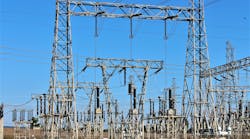On February 15, the Federal Aviation Administration (FAA) and the Department of Transportation (DOT) released a commercial drone regulation framework for drones. Some of the key provisions for the utility industry include:
- Maximum weight of 55 lb (25 kg)
- Visual line-of-sight-only operations
- Daylight-only operations
- Maximum speed of 100 mph (160 kmph) and altitude of 500 ft (152 m)
- Minimum visibility of 3 miles (5 km) to fly a drone
- No operator may operate more than one drone at a time
- Commercial drone operators will have to pass an FAA approved test.
What does this mean to the industry? It means flying drones during a storm is a no-no; pre-storm is probably a no-no, as well. Flying drones along lines or behind trees that might obscure the view of the drone from the ground is also a no-no. Therefore, a drone cannot be used to patrol a line after a storm unless the operator or observer can keep up with the drone and keep it in view at all times.
Almost all military airframes will be too heavy to meet the requirements, so drones will have to come from non-military R&D sources. Several drone experiments were looking at vehicle-mounted drone launchers as well as drones developed by the Army to provide high-quality patrol capabilities.
No “pop-up” operation where a drone is used as either a communications relay or an “area sweep” for damage is prohibited. The upper limit is 500 ft , so drones will not be able to see more than a mile or two from the current location, even with great cameras, and they will not be able to get the best angle to see the actual damage. Also, drone swarms that look at circuits from several angles at the same time are not allowed.
While the rules framework will allow routine patrols, a new vehicle type for the industry will be necessary if the observer or operator is going to keep the drone in sight during these patrols. The observer is going to have to keep up with the drone; most patrol drones will likely travel at 5 mph to 10 mph (8 kmph to 16 kmph), not 100 mph. The operator can’t walk with the control equipment fast enough to keep up for very long, even at 5 mph, and keep the drone in view, so it is likely that a control vehicle with a 360-degree view will have to be developed.
Drones will provide a low-cost way to get nameplate data off of pole-mounted equipment and to conduct infrared or other sensing on installed equipment, but probably only for a few poles for each launch and recovery.
Storm patrols will end up being very short, maybe 0.5 miles to 2.5 miles (1 km to 4 km) at a time, if there are hazards in the road. Drones cannot fly the whole of a circuit at a time. Instead, crews will have to launch and retrieve drones to look at the next area down the street, which increases the time required to collect data to make the most effective recovery plan.
The rules framework is not a final set of regulations, but it does indicate the direction the FAA is leaning. If the industry does not start pushing hard for exceptions from the framework, most of the proposed ideas for the future use of drones in our industry will be forbidden. For example, the framework does not support communications relay during storm or natural disaster recovery, area photography for damage assessment, automated patrol of feeders and circuits, and logistics support for field work. Also omitted is the use of pop-up drones in substations and at other critical facilities to provide “eyes on” potential threats to the facility so security personnel have a better understanding of the situation when they arrive on site. These types of operation are essentially forbidden by the FAA framework, and as final rules are created, the restrictions will probably grow.
The good news, however, is that the FAA has approved several experiments that are outside the parameters of the framework. The first is a test of Amazon’s delivery drones. They have to conform to the maximum weight and many of the other rules, but they will be allowed to fly outside of the visual line of sight in a restricted test area. The second is a utility project to allow licensed pilots to fly drones in the vicinity of the power lines as well as outside of a direct line of sight. Again, the test parameters are tight, and the requirement for a licensed pilot is interesting. These trial uses of drones offer hope to the utility industry that the FAA may be more flexible in its rules than the initial Feb. 15 release indicated.
As an industry, we need to be proactive with the FAA if we think that drones will be useful in protecting critical infrastructure, reducing outage time and improving our understanding of the condition of the grid. Drones could be a wonderful tool to improve how we deliver electricity to customers.
If you want to use drones actively in the grid, now is the time to speak up and share your thoughts.


